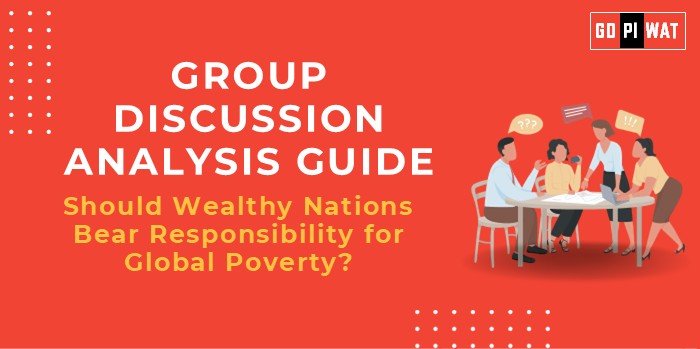📋 Group Discussion (GD) Analysis Guide
🌍 Topic: Should Wealthy Nations Bear the Responsibility for Solving Global Poverty?
🌐 Introduction to the Topic
📖 Opening Context
The divide between affluent nations and impoverished populations underscores a pressing ethical and practical debate: should wealthy countries, with their resources and capabilities, lead the fight against global poverty?
📜 Topic Background
The United Nations’ Sustainable Development Goals (SDGs) identify eradicating poverty as a global priority. The debate hinges on ethical responsibility, economic implications, and geopolitical considerations, especially post-pandemic when poverty rates surged globally.
📊 Quick Facts and Key Statistics
- 📉 Extreme Poverty: Over 700 million people live on less than $2.15 a day (World Bank, 2023).
- 💰 Global Wealth Inequality: The richest 10% own 76% of global wealth (Credit Suisse, 2023).
- 💵 Aid Contribution: The OECD nations contributed $186 billion in official development assistance (ODA) in 2023.
- 🌍 Cost of Eradicating Extreme Poverty: Estimated $350 billion annually (UNDP, 2022).
🤝 Stakeholders and Their Roles
- 🏛️ Wealthy Nations: Contribute through financial aid, technology transfer, and trade policies.
- 🌍 Developing Nations: Implement poverty alleviation programs with external aid.
- 🌐 Global Organizations: Facilitate funding and coordination (e.g., World Bank, IMF, UN).
- 📢 NGOs and Private Sector: Drive grassroots development and innovation.
🏆 Achievements and Challenges
✨ Achievements
- ✅ Reduction in Global Poverty: Extreme poverty dropped from 35% in 1990 to 9% in 2023.
- 🌟 Successful Programs: Initiatives like the Global Fund (health-focused aid) saved millions of lives.
- 🤝 Partnerships: GAVI Alliance improved vaccination in low-income countries.
⚠️ Challenges
- 📉 Aid Dependency: Risks undermining local economic growth.
- ⚔️ Geopolitical Influence: Conditional aid compromises sovereignty.
- 💸 Ineffective Utilization: Corruption and mismanagement of funds in recipient nations.
🌍 Global Comparisons
- 🌟 Success: Scandinavian countries allocate 1% of GDP for foreign aid.
- ⚠️ Challenges: The US allocates only 0.18% of GDP for aid.
- 🇨🇳 China: Prioritizes domestic goals but has lifted 800 million people out of poverty.
📚 Case Studies
- 🇧🇩 Bangladesh: Microfinance programs by Grameen Bank significantly reduced poverty rates.
- 🌍 Sub-Saharan Africa: Mixed results in aid effectiveness due to governance issues.
💡 Structured Arguments for Discussion
- ✅ Supporting Stance: “Wealthy nations have ethical and historical obligations to aid impoverished nations.”
- 🛑 Opposing Stance: “Poverty eradication requires local solutions; external aid fosters dependency.”
- ⚖️ Balanced Perspective: “Collaboration between wealthy nations, developing countries, and NGOs is essential.”
🎯 Effective Discussion Approaches
- 📖 Quote: “Poverty anywhere is a threat to prosperity everywhere” (John F. Kennedy).
- 📊 Statistic: Highlight global poverty trends or disparity in aid contributions.
- ⚡ Counter-Argument Handling: Counter “aid fosters dependency” by citing successful self-sustaining programs like India’s Green Revolution.
🧠 Strategic Analysis: SWOT
- 💪 Strengths: Financial resources, advanced technology, and global influence of wealthy nations.
- 🛠️ Weaknesses: Aid inefficiency, dependency risks, and political conditionalities.
- 🌟 Opportunities: SDGs, technology-led solutions, and public-private partnerships.
- ⚠️ Threats: Rising nationalism, donor fatigue, and global economic crises.
🏫 Connecting with B-School Applications
📚 Real-World Applications
- 🌍 Exploring CSR strategies or international trade policies for poverty alleviation.
🎓 Sample Interview Questions
- ❓ “Should aid be conditional on governance reforms?”
- ❓ “How can businesses align with poverty reduction goals?”
📘 Insights for Students
- 💡 Importance of financial inclusion and public-private collaboration.


